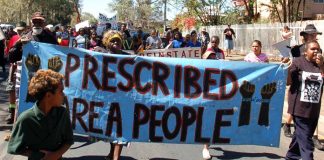Review: Possession
By Bain Atwood, Melbourne University Press, $54.99
The introduction to Possession argues, “the principle challenge to the Australian nation’s sense of itself as morally good has lain in the knowledge that the land was, and perhaps still is, someone else’s, and that it was taken without the Aboriginal people’s consent”.
The history wars waged under Howard are a testament to this. His savage attacks on Aboriginal rights and the defunding of Aboriginal organisations were coupled with the promotion of a view of Australian history that denied the genocide at the founding of the Australian settler state.
Throughout Australia’s history, the argument that Aboriginal people have no rights to land has been a crucial element in establishing the legitimacy of the settler government. The current Northern Territory Intervention, for example, has seen Aboriginal land compulsorily acquired by the Australian government.
This has been justified by the racist idea that Aboriginal people are incapable of looking after their lands and communities. Powerful government agencies are, just like the early colonists, presented as the source of reason and progress.
Possession explores both the “founding” of Port Phillip (Melbourne) in 1835 and the way this has been memorialised—and protested—throughout Victoria’s history.
From the very moment of colonisation governments and aspiring landholders have tried to develop myths to justify their possession.
Batman’s treaty
Attwood’s study focuses on John Batman, still popularly understood as the founder of Melbourne. Batman led the Port Phillip Association, a cabal of pastoralists and colonial elites in Van Diemen’s Land (Tasmania), pushing for the expansion of the colony onto the mainland. For anyone trying to understand the roots of anti-Aboriginal racism, the distinctly capitalist imperatives driving this are worth noting:
“The men of the Port Phillip Association knew what they wanted. British demand for wool in the 1820s had made good pastoral land scarce and costly in Van Diemen’s Land, so they were looking for another place to invest their surplus capital and make a fortune. Port Phillip seemed to fit the bill nicely”.
Many in the Port Phillip Association were veterans of the recent “Black war” in Tasmania. This reduced the 5000 Aboriginal inhabitants to just 200. Batman himself played a direct role in this. Attwood confirms his murder of two men as the leader of an official “conciliation party”, and cites historians who claim he shot 15 in a single massacre.
Despite this bloody history, the Port Phillip Association tried to present themselves as humanitarian towards Aboriginal people. They drew up a “treaty” with the Kulin who lived at Port Phillip, promising them a yearly payment of goods such as tomahawks and blankets in exchange for the rights to the surrounding lands.
While a ceremonial meeting may have taken place between the Kulin and Batman’s party, there is no way the local people thought they were ceding their lands. The entire exercise was an opportunistic attempt to try and win title in the eyes of the colonial government.
However, the treaty was not recognised by the colonial courts. It threatened to undermine the emerging doctrine of British sovereignty over the entire Australian landmass.
Foundation myths
Through the 19th and early 20th centuries, stories that invoked Batman as the founder of the city very rarely mentioned the treaty.
In his journal, Batman wrote about traveling up the Yarra river, proclaiming “this will be the place for the village—with the natives on shore”. This passage became mythologised as a foundational prophesy, especially through Melbourne’s 1935 centenary celebrations.
But his reference to “the natives” disappeared from the historical record, mirroring their butchering at the hands of the settler state. Sixty-eight separate massacres took place in the 15 years following Batman’s arrival in Port Phillip and the Koori population was reduced by 60 per cent.
Possession is also the story of Koori protest against these foundational myths. Despite the nature of the treaty, it provided a shard of recognition for the Aboriginal people and became something of a rallying point for early waves of political activism.
William Cooper, founder of the Aboriginal Advancement League, attended a white commemoration of Batman organised in 1937, demanding that “in future gatherings the notice of the white people be called to the residue (of Aborigines), left after the white man satiated himself in the blood of the Aboriginal”.
In the early 1960s, an Aboriginal rally demanding rights over Lake Tyres, a reserve in Victoria threatened with closure, began at the Batman memorial.
However, as the land rights movement gained steam, Koori activists publicly denounced Batman for his crimes and destruction of copies of the treaty became a symbolic political action.
With Rudd continuing a new wave of colonisation in the NT and across Australia, Possession is a timely reminder that the living legacy of Aboriginal dispossession and the unsettled question of stolen land cannot be apologised away.
By Paddy Gibson





